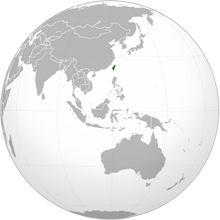| The following Sino-Japanese Alliance page is under construction.
Please do not edit or alter this article in any way while this template is active. All unauthorized edits may be reverted on the admin's discretion. Propose any changes to the talk page. |
| |||||||
| Capital | Taipei | ||||||
| Largest city | Taichung Trade Zone | ||||||
| Language official |
Chinese and Japanese | ||||||
| others | Dutch, Hokkien, | ||||||
| Religion main |
Buddhism | ||||||
| others | Shinto, Confucianism, Xuanyuanism, | ||||||
| Ethnic Groups main |
Hokkien | ||||||
| others | Han, Japanese, | ||||||
| Demonym | Formosan | ||||||
| Government | Democratic Free Market Republic | ||||||
| Legislature | Formosan Yuan | ||||||
| Population | 30,000,000 | ||||||
| GDP Total: |
$1.5 Trillion | ||||||
| per capita | $50,000 | ||||||
| Established | January 5th, 1920 | ||||||
| Currency | Asian Dollar | ||||||
| Time Zone | Formosan Standard Time | ||||||
| Driving Side | Right | ||||||
| Calling Code | .886 | ||||||
| Internet TLD | .frm | ||||||
Formosa (Chinese: 福尔摩沙, Fu-Ermosha. Japanese: フォルモーザ, Forumoza), officially known as the Republic of Formosa (Chinese: 台塑共和国 , Gonghe Taisu, Japanese: フォルモサ共和国, Forumoza Kyowakoku) , is a state in East Asia lying in between the Superpowers of Japan and China.
Formosa was originally formed as a neutral zone between Japan and China to ensure the Sino-Japanese Alliance. During this period, Formosa experienced a growth of culture and industry, which it continued to experience as it became known as the "Asian Switzerland'. This all changed with the Sino-Japanese Split when a Japanese backed coup established Pro-Japan Kingdom of Formosa. This triggered the Formosan War, when a united opposition movement based out of Taichung fought against the Monarchists. This was, until China decided to intervene and support the Authoritarian Formosan Kuomintang, which caused the splintering of the opposition and prolonging the war. Additionally, a Soviet-US supported faction known as Hokkien Freedom Movement which pushed for Formosan Independence from the GACPA, was also established. Eventually, the Formosan Marketeers, who supported the previous status quo, ended up winning, although some Hokkien rebellions continued for some more years. After that, Formosa retook its position as the Asian Switzerland and continued economic growth, with the Formosan Stock Exchange becoming the center of the GACPA Economic Alliance.
Formosa is a unique blend of Japanese, Chinese, and Native cultures that is diverse. Its cities are huge and it is grand. It is also known as the Asian Switzerland due to its state as a Financial Hub and due to its Complete Neutrality.
Etymology[]
The Word Formosa comes from the Portuguese word for "Beautiful" as Portuguese explorers called it the Beautiful Island. It is also sometimes known as Taiwan as that is its Japanese name.
History[]
Main Articles: History of Taiwan and Timeline
Formation[]
The Republic of Formosa was established in 1920 with the Treaty of Formosa that established a neutral zone between Japan and China as well as having both Japan and China protect the Independence of Formosa. Through this period, Formosa experienced steady economic growth as it began to lean more towards Japan than China. Formosa also became one of the only countries in Asia to establish a fully functioning democracy. Three major parties emerged, the Kuomintang (who favored a Chinese influenced Formosa), the Liberals (who favored a neutral Formosa), and the Conservatives (who favored a Japanese influenced Formosa).
Kingdom of Formosa[]
Main Article: The Kingdom of Formosa
When socialist president Hua Guofeng was elected in 1950, the conservative financiers and bureaucrats felt threatened and overthrew him in a Japanese backed coup. They thought Democracy was a failed experiment and formed the autocratic puppet state known as the Kingdom of Formosa. The Liberals and Kuomintang were outraged and started their own state in the city of Taichung that continued the republic.
Formosan War[]
Main Article: Formosan War and Sino-Japanese Split
Soon, the rebels in Taichung controlled the entirety of the lower half of the island, leaving the Kingdom isolated to the northern cities of Taipei and New Taipei. The Japanese began militarily supplying the Kingdom, which the Chinese viewed as a violation of the Treaty of Formosa. The Chinese began supplying the Republic as well as boosting the authoritarian Kuomintang within the Republic. The Communists also saw their chance due to the big socialist movement and began funding the Socalist Party in Formosa. This led to a split of rebels into the Republic of Formosa (Liberal ruled), the State of Formosa (Kuomintang ruled), and the People's Republic of Formosa (Socialist Ruled). Eventually, the Liberals would see victory over the other states (except for socialist insurgencies in the countries interior which go on to the present day).
Modern Formosa[]
Modern Formosa has regained its status as the Asian Switzerland, with Taichung being the primary place where the Asian Dollar is minted. Taichung is also the capital of the GACPA, and was chosen due to its neutrality and being the relative center of the alliance.
Government and Politics[]
Administrative Divisions[]
Formosa is divided up into several autonomous cities that each have unique culture due to an influx of immigrants from different areas.
Demographics[]
Ethnography[]
Formosa is extremely ethnically diverse, although most of its ethnicities are from Asia. The largest ethnicities are the Hokkien (Han Chinese mixed with Formosan Aborigine), Japanese, Indonesians/Malaysians, Thai/Burmese, and Indians. There is also a very small Indochinese population. White populations include business people from the American Pacific States (Cascadia, Alaska, California, Norte) and Australians.
Religion[]
Most people in Formosa are irreligious, but others practice traditional Chinese and Japanese religions, with small Muslim, Buddhist, and Christian minorities.
Language[]
Formosa is a multilingual country, with the primary languages being Mandarin and Japanese.




